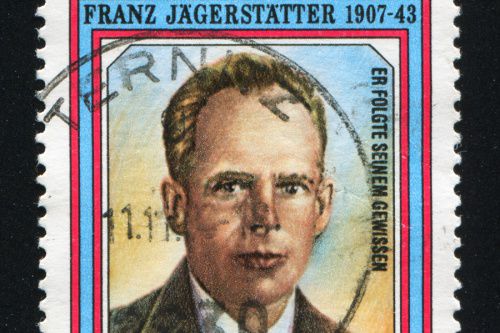One theme unifies the stories of all the saints: Christians are never alone. Even in the most isolated circumstances, saints have a profound union with God. This principle is demonstrated by the martyrdom of Franz Jagerstatter, a father and martyr during the Nazi occupation of Austria.
A peasant background
Franz was no St. Therese. He was the illegitimate child of a maidservant in a tiny village in Upper Austria. His mother married when Franz was 10.
Franz was a wild child. He was a womanizer, and even had a daughter born out of wedlock. Gordan Zahn, whose book In Solitary Witness is the definitive work on Jagerstatter’s life, discovered that Jagerstatter was exiled from his community for several years, during which time he stopped attending Mass.
However, Jagerstatter received a passable education in the village’s one-room school schoolhouse before becoming a farmer. Then he met his wife.
Marriage transformed him
He married Franziska Schwaninger on Holy Thursday 1936. On their honeymoon, they received a blessing from Pope Pius XI.
Franziska’s effect on her husband was subtle but persistent. Jagerstatter became the sexton of the village church, meaning he assisted at all the liturgies and maintained the building. This led to him becoming a daily communicant. He began to memorize the Bible and learn the lives of the saints. In fact, he once told his wife, “I could have never imagined that being married could be so wonderful.”
Road to martyrdom
Jagerstatter and Franziska had three girls together, and remained close to his other daughter. In 1938, around the time their eldest daughter was born, Germans invaded Austria.
The Catholic Church in Austria had warned against Nazi socialism for years. Catholics in Germany were facing severe restrictions, including the prohibition of Mass outside of Sundays, even for the holiest solemnities and feast days. Jagerstatter’s own pastor had been jailed for delivering an anti-Nazi sermon. His bishop had dictated an anti-Nazi letter to be read in all the parishes several years earlier. That same bishop would declare, “It is impossible to be both a good Catholic and a true Nazi.” He was later replaced with a bishop who spoke more cautiously.
The same pope who had blessed Jagerstatter’s marriage, Pius XI, in 1937 published the encyclical Mit brennender Sorge, on the strained relations between the Church and Nazi Germany.
Buoyed by these witnesses, Jagerstatter was still the only person in his whole town to disavow Anschluss, or the German annexation of Austria. He was dismayed to see many Catholics support the Nazis. One cardinal even demanded that all parishes fly the Nazi flag from their churches on Hitler’s birthday.
“I believe there could scarcely be a sadder hour for the true Christian faith in our country,” he wrote.
The prevailing idea at the time was that a peasant layman should do what his country told him to do. By this obedience, the people who made the decisions, and not the peasant, would hold moral responsibility for the actions. But Franz couldn’t reconcile that worldview with the fact that he had free will, and that he could not call himself a disciple if he bowed that will to a movement he viewed as satanic. He would not fight for the Nazis.
At first it seemed that being a farmer would keep him from fighting—Germany’s massive army required equally massive amounts of food. Unfortunately, in 1943 the need for fighters grew, and Jagerstatter was called to active duty. He went to the induction center, where he announced that he would not fight. He was summarily carted to the military prison at Linz to learn his fate.
“I am convinced it is best that I speak the truth, even if it costs me my life,” he wrote.
Saints have saints for friends
Friends, family and even the local bishop visited Jagerstatter in prison, trying to convince him to fight. None of these visitors gave him a convincing argument against his moral convictions about conscientious objection. Instead, they all tried to convince him that God would not hold him accountable for doing what his state ordered. Jagerstatter was unconvinced.
“Since the death of Christ, almost every century has seen the persecution of Christians; there have always been heroes and martyrs who gave their lives — often in horrible ways — for Christ and their faith. If we hope to reach our goal someday, then we, too, must become heroes of the faith,” he said.
His wife accepted his need to follow his conscience. He was also part of a movement of Catholic martyrs who gave their life to fight the Nazis.
St. Theresa Benedicta of the Cross (Edith Stein) had died the previous August in Auschwitz, almost a year to the day after St. Maximillian Kolbe. Blessed Marcel Callo was just beginning the undercover Catholic activities in his forced labor camp that would eventually lead to his 1945 martyrdom for being “too Catholic.”
Most impressively, Jagerstatter spent May to August of 1943 in the same prison as the renowned Lutheran pastor and martyr Dietrich Bonhoeffer. There is not evidence that the two men ever met, or even realized they shared a prison with someone so similar in conviction. Jagerstatter was able to learn, though, of a priest who had been martyred in the same prison for the exact reasons he and so many others shared.
That conviction ultimately cost him his life. He was taken to Berlin, where he was sentenced to death for sedition. His last recorded words before he met the guillotine are, "I am completely bound in inner union with the Lord."
The Church agreed. During Vatican II, Jagerstatter’s life helped shape the section of Gaudium et spes that talks about conscientious objectors to war. He was beatified 50 years after his death. His daughters, grandchildren, and great-grandchildren attended the ceremony.
This article first appeared in the Denver Catholic.

